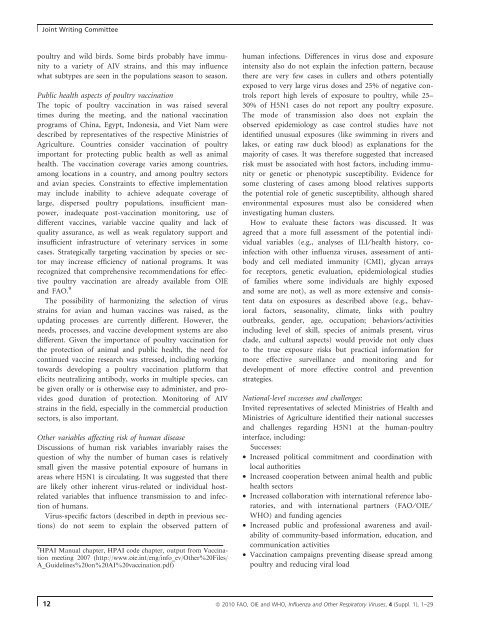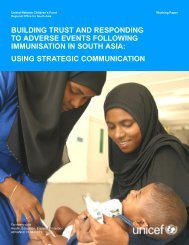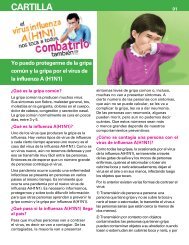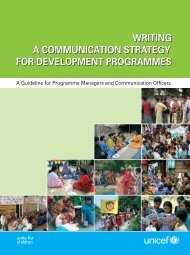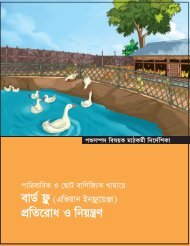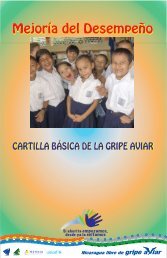FAO-OIE-WHO Joint Technical Consultation on Avian Influenza at ...
FAO-OIE-WHO Joint Technical Consultation on Avian Influenza at ...
FAO-OIE-WHO Joint Technical Consultation on Avian Influenza at ...
- No tags were found...
You also want an ePaper? Increase the reach of your titles
YUMPU automatically turns print PDFs into web optimized ePapers that Google loves.
<str<strong>on</strong>g>Joint</str<strong>on</strong>g> Writing Committeepoultry and wild birds. Some birds probably have immunityto a variety of AIV strains, and this may influencewh<strong>at</strong> subtypes are seen in the popul<strong>at</strong>i<strong>on</strong>s seas<strong>on</strong> to seas<strong>on</strong>.Public health aspects of poultry vaccin<strong>at</strong>i<strong>on</strong>The topic of poultry vaccin<strong>at</strong>i<strong>on</strong> in was raised severaltimes during the meeting, and the n<strong>at</strong>i<strong>on</strong>al vaccin<strong>at</strong>i<strong>on</strong>programs of China, Egypt, Ind<strong>on</strong>esia, and Viet Nam weredescribed by represent<strong>at</strong>ives of the respective Ministries ofAgriculture. Countries c<strong>on</strong>sider vaccin<strong>at</strong>i<strong>on</strong> of poultryimportant for protecting public health as well as animalhealth. The vaccin<strong>at</strong>i<strong>on</strong> coverage varies am<strong>on</strong>g countries,am<strong>on</strong>g loc<strong>at</strong>i<strong>on</strong>s in a country, and am<strong>on</strong>g poultry sectorsand avian species. C<strong>on</strong>straints to effective implement<strong>at</strong>i<strong>on</strong>may include inability to achieve adequ<strong>at</strong>e coverage oflarge, dispersed poultry popul<strong>at</strong>i<strong>on</strong>s, insufficient manpower,inadequ<strong>at</strong>e post-vaccin<strong>at</strong>i<strong>on</strong> m<strong>on</strong>itoring, use ofdifferent vaccines, variable vaccine quality and lack ofquality assurance, as well as weak regul<strong>at</strong>ory support andinsufficient infrastructure of veterinary services in somecases. Str<strong>at</strong>egically targeting vaccin<strong>at</strong>i<strong>on</strong> by species or sectormay increase efficiency of n<strong>at</strong>i<strong>on</strong>al programs. It wasrecognized th<strong>at</strong> comprehensive recommend<strong>at</strong>i<strong>on</strong>s for effectivepoultry vaccin<strong>at</strong>i<strong>on</strong> are already available from <str<strong>on</strong>g>OIE</str<strong>on</strong>g>and <str<strong>on</strong>g>FAO</str<strong>on</strong>g>. 9The possibility of harm<strong>on</strong>izing the selecti<strong>on</strong> of virusstrains for avian and human vaccines was raised, as theupd<strong>at</strong>ing processes are currently different. However, theneeds, processes, and vaccine development systems are alsodifferent. Given the importance of poultry vaccin<strong>at</strong>i<strong>on</strong> forthe protecti<strong>on</strong> of animal and public health, the need forc<strong>on</strong>tinued vaccine research was stressed, including workingtowards developing a poultry vaccin<strong>at</strong>i<strong>on</strong> pl<strong>at</strong>form th<strong>at</strong>elicits neutralizing antibody, works in multiple species, canbe given orally or is otherwise easy to administer, and providesgood dur<strong>at</strong>i<strong>on</strong> of protecti<strong>on</strong>. M<strong>on</strong>itoring of AIVstrains in the field, especially in the commercial producti<strong>on</strong>sectors, is also important.Other variables affecting risk of human diseaseDiscussi<strong>on</strong>s of human risk variables invariably raises thequesti<strong>on</strong> of why the number of human cases is rel<strong>at</strong>ivelysmall given the massive potential exposure of humans inareas where H5N1 is circul<strong>at</strong>ing. It was suggested th<strong>at</strong> thereare likely other inherent virus-rel<strong>at</strong>ed or individual hostrel<strong>at</strong>edvariables th<strong>at</strong> influence transmissi<strong>on</strong> to and infecti<strong>on</strong>of humans.Virus-specific factors (described in depth in previous secti<strong>on</strong>s)do not seem to explain the observed p<strong>at</strong>tern of9 HPAI Manual chapter, HPAI code chapter, output from Vaccin<strong>at</strong>i<strong>on</strong>meeting 2007 (http://www.oie.int/eng/info_ev/Other%20Files/A_Guidelines%20<strong>on</strong>%20AI%20vaccin<strong>at</strong>i<strong>on</strong>.pdf)human infecti<strong>on</strong>s. Differences in virus dose and exposureintensity also do not explain the infecti<strong>on</strong> p<strong>at</strong>tern, becausethere are very few cases in cullers and others potentiallyexposed to very large virus doses and 25% of neg<strong>at</strong>ive c<strong>on</strong>trolsreport high levels of exposure to poultry, while 25–30% of H5N1 cases do not report any poultry exposure.The mode of transmissi<strong>on</strong> also does not explain theobserved epidemiology as case c<strong>on</strong>trol studies have notidentified unusual exposures (like swimming in rivers andlakes, or e<strong>at</strong>ing raw duck blood) as explan<strong>at</strong>i<strong>on</strong>s for themajority of cases. It was therefore suggested th<strong>at</strong> increasedrisk must be associ<strong>at</strong>ed with host factors, including immunityor genetic or phenotypic susceptibility. Evidence forsome clustering of cases am<strong>on</strong>g blood rel<strong>at</strong>ives supportsthe potential role of genetic susceptibility, although sharedenvir<strong>on</strong>mental exposures must also be c<strong>on</strong>sidered wheninvestig<strong>at</strong>ing human clusters.How to evalu<strong>at</strong>e these factors was discussed. It wasagreed th<strong>at</strong> a more full assessment of the potential individualvariables (e.g., analyses of ILI ⁄ health history, coinfecti<strong>on</strong>with other influenza viruses, assessment of antibodyand cell medi<strong>at</strong>ed immunity (CMI), glycan arraysfor receptors, genetic evalu<strong>at</strong>i<strong>on</strong>, epidemiological studiesof families where some individuals are highly exposedand some are not), as well as more extensive and c<strong>on</strong>sistentd<strong>at</strong>a <strong>on</strong> exposures as described above (e.g., behavioralfactors, seas<strong>on</strong>ality, clim<strong>at</strong>e, links with poultryoutbreaks, gender, age, occup<strong>at</strong>i<strong>on</strong>; behaviors ⁄ activitiesincluding level of skill, species of animals present, virusclade, and cultural aspects) would provide not <strong>on</strong>ly cluesto the true exposure risks but practical inform<strong>at</strong>i<strong>on</strong> formore effective surveillance and m<strong>on</strong>itoring and fordevelopment of more effective c<strong>on</strong>trol and preventi<strong>on</strong>str<strong>at</strong>egies.N<strong>at</strong>i<strong>on</strong>al-level successes and challenges:Invited represent<strong>at</strong>ives of selected Ministries of Health andMinistries of Agriculture identified their n<strong>at</strong>i<strong>on</strong>al successesand challenges regarding H5N1 <strong>at</strong> the human-poultryinterface, including:Successes:• Increased political commitment and coordin<strong>at</strong>i<strong>on</strong> withlocal authorities• Increased cooper<strong>at</strong>i<strong>on</strong> between animal health and publichealth sectors• Increased collabor<strong>at</strong>i<strong>on</strong> with intern<strong>at</strong>i<strong>on</strong>al reference labor<strong>at</strong>ories,and with intern<strong>at</strong>i<strong>on</strong>al partners (<str<strong>on</strong>g>FAO</str<strong>on</strong>g> ⁄ <str<strong>on</strong>g>OIE</str<strong>on</strong>g> ⁄<str<strong>on</strong>g>WHO</str<strong>on</strong>g>) and funding agencies• Increased public and professi<strong>on</strong>al awareness and availabilityof community-based inform<strong>at</strong>i<strong>on</strong>, educ<strong>at</strong>i<strong>on</strong>, andcommunic<strong>at</strong>i<strong>on</strong> activities• Vaccin<strong>at</strong>i<strong>on</strong> campaigns preventing disease spread am<strong>on</strong>gpoultry and reducing viral load12 ª 2010 <str<strong>on</strong>g>FAO</str<strong>on</strong>g>, <str<strong>on</strong>g>OIE</str<strong>on</strong>g> and <str<strong>on</strong>g>WHO</str<strong>on</strong>g>, <strong>Influenza</strong> and Other Respir<strong>at</strong>ory Viruses, 4 (Suppl. 1), 1–29


